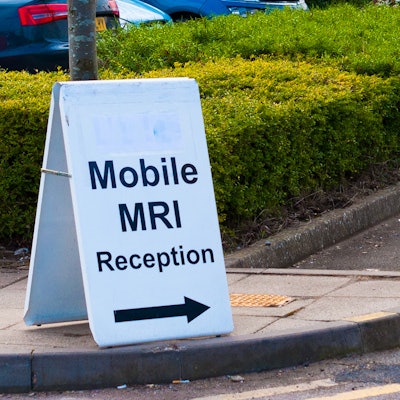
An analysis of mobile MRI scanners in the U.K. shows compliance with standards for safe electromagnetic field (EMF) exposure for full-time clinical staff, but training should be implemented to further reduce exposure during the working week and when imaging patients.
While the results are somewhat comforting and do not indicate excessive EMF exposure, researchers at InHealth, a diagnostic and healthcare services provider to the National Health Service (NHS) and independent practitioners, recommended additional studies are needed for both mobile units and in-house imaging centers to ensure proper EMF levels.
"We would advise that both types of facilities -- static and mobile -- conduct epidemiological studies of possible long-term health effects, promote the use of dosimeters for all MRI workers, and monitor their occupational exposure," said lead author Ana Filip Sousa, who presented the results at ECR 2018 in Vienna.
EMF Directive
The issue of workers' exposure to electromagnetic fields and how to best regulate potential effects from constant exposure has been long debated. Back in 2010, MRI advocates sought to establish EMF standards that would not limit work at research labs or serving patients at radiology centers. Their lengthy campaign culminated in July 2016, when the Control of Electromagnetic Fields at Work Regulations went into effect, with little impact on MRI facilities.
While most MRI activities are exempt from occupational exposure limits in the regulations, employers are still required to follow certain safety mandates. The EMF Directive, for example, requires employers to determine the EMF risk separately for each workplace to ensure no workers are exposed to excessive levels. Adverse side effects, such as dizziness, nausea, and headaches, have been noted in previous studies when staff and patients are exposed EMF levels greater than 100 microtesla (µT).
There also are intrinsic hazards related to the increased number of requests for MRI scans and the advent of magnets with greater field strengths. This increasing utilization of MRI is particularly prevalent with mobile services.
"Limits have been proposed for MRI staff, but due to the absence of data, concerns have been raised about health and safety requirements regarding exposure of workers to risks arising from electromagnetic fields in the absence of information about exposure on mobile MRI units," Sousa told ECR attendees.
Location, location, location
In this study, Sousa and colleagues sought to measure staff exposure to EMF during three of the most frequently performed scans in mobile MRI units. The researchers took five mobile InHealth MRI systems from the same manufacturer and at the same 1.5-tesla magnetic field strength (Symphony, Siemens Healthineers).
After determining the three most common MRI procedures conducted in the mobile units, they used a dosimeter to compare EMF levels for clinicians during scans of different body parts and the MR imaging protocols for each anatomic region. The third task was to compare EMF levels in different locations of the mobile MRI unit using a standard quality assurance phantom.
The most common scans were performed on the lumbar spine, knee, and brain. The researchers took data from 98 patients with a mean age of 49.2 years (± 16 years) and no significant difference between the subjects' height and weight among the three clinical applications. Among the subjects, 35 scans were performed on the lumbar spine and/or brain, while 33 exams were conducted on the knee.
The researchers then correlated the anatomic regions scanned under 1.5-tesla with amplitude and frequency readings from the dosimeter. They found no statistically significant difference in comparisons for the lumbar spine, knee, and brain scans and levels below acceptable levels of 100 µT.
| Amplitude and frequency readings based on region in 1.5-tesla MRI scans | |||
| Mean amplitude | Mean frequency | p-values* | |
| Lumbar spine | 0.74 µT | 68 µT | > 0.05 |
| Knee | 0.74 µT | 51 µT | > 0.05 |
| Brain | 1.01 µT | 57 µT | > 0.05 |
In considering EMF levels at the four different locations in the mobile unit, amplitude readings from the magnetic field expectedly deviated the most the further away clinicians were from the scanner. Exposure was reduced and remained within acceptable levels.
"It shows that the flux density of the static magnetic field varies with the distance from the scanner and as far as the workers will be from the scanner room," Sousa said. "Exposure also will be less, which has been proven in the studies amplitude values deviation with the probe's position."
In summary, the researchers concluded that EMF levels for the five mobile MRI units were within compliance standards.
"However, it would be interesting to promote training for MRI mobile workers, in order to present methods for their exposure reduction during patients attending," she added. "Further research on this subject would be helpful and interesting, not just on the mobile units but also at other facilities.



















